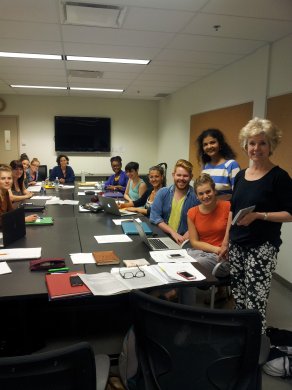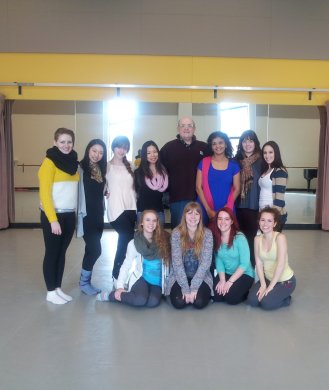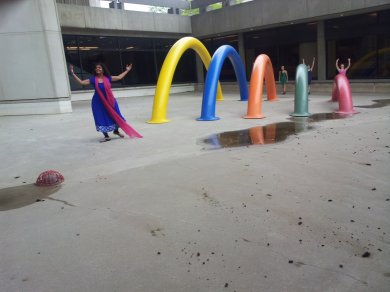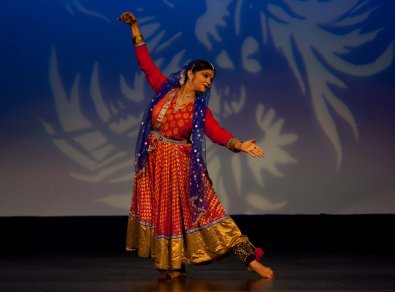
|
 |

|
 |
From Question to Quest: Is the answer within the journey itself? - Shila Mehta e-mail: mehtashila@hotmail.com Photos courtesy: Shila Mehta June 18, 2014 Too many questions can confuse us. On the other hand, one good question may bring about profound change through its call for significant efforts to explore meaning and to find answers. I definitely realize the power of 'what' and 'why' when a Question becomes a Quest.  With Carol Anderson at York Uni  With Darcey Callison at York Uni Dance has taken me to many places over the years, and most recently, the University of Toronto, Canada. Here I was fortunate to meet and work with a number of dance artists and academicians, each of whom left their mark on challenging my thinking and work as an artist. Darcey Callison, a choreographer, dance scholar and cultural theorist planted the following seed in my mind that "everything does not have to make sense." Simple, yet transformational words, pushing me to ask myself… crossing internal boundaries as a choreographer, and to my surprise, utilizing a 'smart phone' for the first time to aid artistic endeavor. Similarly, Carol Anderson, a choreographer and dance writer, observed me during a choreography session. Whilst reflecting on my movements she forced me to think about it from a new direction, which ultimately led to my exploring how to dance from my 'bones.' As an Indian classical dancer, I have become so accustomed to the story telling element of Kathak which requires me to emote to express my inner feelings and to communicate rasa to the audience. Carol was essentially challenging me to talk to different parts of the body before creating any movement. The highlight of this process of dancing from the 'bones' was actually connecting with bodily elements in a new way that enabled the creation of movements that were strangers to my body-unexplored. I observed how my movements became enriched - extending my movement vocabulary - yet outside of the comfort zone of storytelling. To my surprise, without any narrative in mind, it was as if my body elements were creating their own stories and in doing so providing a burst of fresh energy in dance. Holly William, a renowned dance choreographer's unique approach to the utilization of space questioned me to choreograph in open air and around rainbow pillars with my closest friends - the syllables of Kathak, TA, DHIN, DHA, DIN. It was refreshing to observe dance students of contemporary style, for whom my friends were unknown, embrace their energy through movement, despite the fact that to them, they did not make sense in the way that I have come to connect. Kathleen Rea, a dance therapist, shared her unpleasant life experience with dance, which questioned her on body wisdom. As a first exposure to dance as therapy and revisiting my own dance experience, my belief in using dance as an effective medium to connect to oneself was reaffirmed. I started to ask myself about all the people I had helped to connect with them through Kathak dance. What had they each gained? Is it an internal search that led them to dance to begin with? Julia Sasso, one of the foremost established choreographers of Canada, raised questions on the inner body, which became my quest for journeying into searching for lightness within. The technique of releasing a dancer's body to bring lightness pushed me down the line of questioning myself as to why, in the main, training in Indian dance does not include such explicit attempt to educate students in the strategies that help to create feeling within the dancer and also visually striking movements. As a trainer, I often find it challenging to bring about accelerated development within students as their body clings on to its habits. Releasing and alike techniques, on the other hand, allow for the same. In the context of the western approach, the interpretation of Contemporary Dance started making sense to me by first understanding that everything need not make sense. At the same time, this realization raised many questions, which rather than baffling the mind are now paving the path to new directions, innovations and connections to my thought process.  Site specific Kathak choreography  At Soorya Dance Festival in St. Louis, MO My stay in Canada was further enriched with close association and interactions with Meneka, Rasesh and Sudha Thakkar. While talking to them I realized that much of their work was the result of all the questions that arose for them since the time they landed on foreign grounds in the early 60s. In some way, all of my creations have at their core a driving conviction to learning something or deepening understanding on a subject matter through inner dialogue and questioning. It was great to receive an overwhelming response to my novel presentation of "Katha se Kathak" at the International Festival of Dance organized by Kalanidhi Fine Arts at the Fleck Dance Theatre, Toronto. An enormous amount of good work is being carried out in Canada and the USA along with India, and this surfaced while watching the different performances at the festival. The live streaming of artists and the symposium was also the result of questioning geographical boundaries and technology, putting the latter to good use. My move from India to Canada and now the USA became more satisfying and optimistic while looking at the high standards retained by the purists of classical dance by senior artists like Smitha Rajan, Kamala, Shobha, Shashikala Revathy, Anu Naimpally and Revathi Satyu's students, Prasanna Kasthuri's group in 2nd generation. Credit is due to Prasanna Kasthuri who himself is an established Bharatanatyam dancer and additionally organized a sizeable 3 day Soorya Dance festival - this year dedicated to gurus Kitappa Pillai, Narmada, Vempati Chinna Sathyam, Kalamandalam Krishnan Nair and Kalyani Kutti Amma to which artists from all over the USA were invited. This is not a small undertaking, especially when on foreign land. Again, many questions were raised by Prasanna Kasthuri on the future of dancing, and how long only a dancer's interest in dance will sustain the festival. When I presented Kathak dance on the first day of the festival, I was flooded with compliments from an 8 year old child right up to a senior of 70 years. It definitely made me question if it is still necessary to have group dance choreography to impress audiences when you can communicate the same energy through solo performances and perhaps do better justice to yourself as an artist. I feel that there are so many areas in the field of dance that are yet to be questioned, and that through inquiry something may result in beneficial change. So how about responding to a question with a quest or pursuit that takes us outside of our comfort zone? Something that provides a new sense of purpose and direction and in itself may become the answer to what you are searching for. Kathak dancer Shila Mehta is the director of Nupur Zankar Academy of Performing Arts & Research Center based in Mumbai. Post your comments Please provide your name and email id when you use the Anonymous profile in the blog to post a comment. All appropriate comments posted with name & email id in the blog will also be featured in the site. |